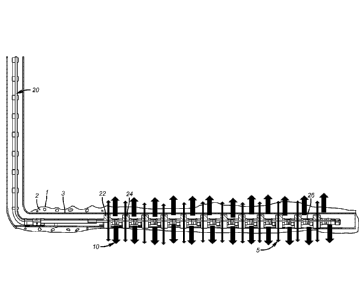Some of the information on this Web page has been provided by external sources. The Government of Canada is not responsible for the accuracy, reliability or currency of the information supplied by external sources. Users wishing to rely upon this information should consult directly with the source of the information. Content provided by external sources is not subject to official languages, privacy and accessibility requirements.
Any discrepancies in the text and image of the Claims and Abstract are due to differing posting times. Text of the Claims and Abstract are posted:
| (12) Patent: | (11) CA 2950156 |
|---|---|
| (54) English Title: | REFRACTURING AN ALREADY FRACTURED BOREHOLE |
| (54) French Title: | REFRACTURATION D'UN TROU DE FORAGE DEJA FRACTURE |
| Status: | Granted |
| (51) International Patent Classification (IPC): |
|
|---|---|
| (72) Inventors : |
|
| (73) Owners : |
|
| (71) Applicants : |
|
| (74) Agent: | MARKS & CLERK |
| (74) Associate agent: | |
| (45) Issued: | 2022-06-14 |
| (86) PCT Filing Date: | 2015-06-04 |
| (87) Open to Public Inspection: | 2015-12-10 |
| Examination requested: | 2020-03-13 |
| Availability of licence: | N/A |
| (25) Language of filing: | English |
| Patent Cooperation Treaty (PCT): | Yes |
|---|---|
| (86) PCT Filing Number: | PCT/US2015/034234 |
| (87) International Publication Number: | WO2015/187973 |
| (85) National Entry: | 2016-11-23 |
| (30) Application Priority Data: | ||||||
|---|---|---|---|---|---|---|
|
A well with existing perforations is re-fractured by positioning isolators at locations offset from the existing perforations and perforating through those isolators. The isolators are part of a bottom hole assembly that can be delivered on coiled or rigid tubing. The initial fractures can be straddled by the isolators with no mandrel openings between them to effectively isolate the existing perforations as new perforations take place through the isolators. The elements of the isolators can have internal gaps to allow for axial shifting after perforation that is thermally induced. The gaps assure remaining alignment with the new perforations despite some axial shifting. The bottom hole assembly can alternatively have an anchor to resist thermally induced forces that can cause axial shifting.
L'invention concerne la refracturation d'un puits doté de perforations existantes en positionnant des isolateurs au niveau d'emplacements décalés des perforations existantes et en perforant à travers ces isolateurs. Les isolateurs font partie d'un ensemble de fond de trou qui peut être fourni sur une tubulure spiralée ou rigide. Les fractures initiales peuvent être chevauchées par les isolateurs, sans ouverture de mandrin entre elles, afin d'isoler efficacement les perforations existantes lorsque les nouvelles perforations ont lieu à travers les isolateurs. Les éléments des isolateurs peuvent avoir des espaces internes afin de permettre un décalage axial après perforation qui est induit par voie thermique. Les espaces garantissent le maintien de l'alignement avec les nouvelles perforations malgré un certain décalage axial. L'ensemble de fond de trou peut, de manière alternative, avoir un ancrage afin de résister aux forces induites par voie thermique pouvant provoquer un décalage axial.
Note: Claims are shown in the official language in which they were submitted.
Note: Descriptions are shown in the official language in which they were submitted.

For a clearer understanding of the status of the application/patent presented on this page, the site Disclaimer , as well as the definitions for Patent , Administrative Status , Maintenance Fee and Payment History should be consulted.
| Title | Date |
|---|---|
| Forecasted Issue Date | 2022-06-14 |
| (86) PCT Filing Date | 2015-06-04 |
| (87) PCT Publication Date | 2015-12-10 |
| (85) National Entry | 2016-11-23 |
| Examination Requested | 2020-03-13 |
| (45) Issued | 2022-06-14 |
There is no abandonment history.
Last Payment of $277.00 was received on 2024-05-21
Upcoming maintenance fee amounts
| Description | Date | Amount |
|---|---|---|
| Next Payment if standard fee | 2025-06-04 | $347.00 |
| Next Payment if small entity fee | 2025-06-04 | $125.00 |
Note : If the full payment has not been received on or before the date indicated, a further fee may be required which may be one of the following
Patent fees are adjusted on the 1st of January every year. The amounts above are the current amounts if received by December 31 of the current year.
Please refer to the CIPO
Patent Fees
web page to see all current fee amounts.
| Fee Type | Anniversary Year | Due Date | Amount Paid | Paid Date |
|---|---|---|---|---|
| Application Fee | $400.00 | 2016-11-23 | ||
| Maintenance Fee - Application - New Act | 2 | 2017-06-05 | $100.00 | 2017-05-08 |
| Maintenance Fee - Application - New Act | 3 | 2018-06-04 | $100.00 | 2018-05-10 |
| Maintenance Fee - Application - New Act | 4 | 2019-06-04 | $100.00 | 2019-05-23 |
| Request for Examination | 2020-06-04 | $800.00 | 2020-03-13 | |
| Maintenance Fee - Application - New Act | 5 | 2020-06-04 | $200.00 | 2020-05-25 |
| Maintenance Fee - Application - New Act | 6 | 2021-06-04 | $204.00 | 2021-05-19 |
| Final Fee | 2022-04-19 | $305.39 | 2022-03-22 | |
| Maintenance Fee - Application - New Act | 7 | 2022-06-06 | $203.59 | 2022-05-18 |
| Maintenance Fee - Patent - New Act | 8 | 2023-06-05 | $210.51 | 2023-05-24 |
| Maintenance Fee - Patent - New Act | 9 | 2024-06-04 | $277.00 | 2024-05-21 |
Note: Records showing the ownership history in alphabetical order.
| Current Owners on Record |
|---|
| BAKER HUGHES INCORPORATED |
| Past Owners on Record |
|---|
| None |